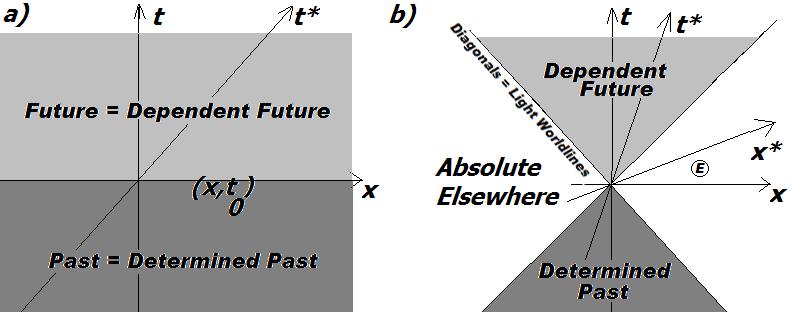A century ago, “past” and “future”, previously strictly apart, mixed up and merged. Temporal terminology improved. Today, not actualized quantum states, that is merely “possible” alternatives, objectively “exist” (are real) when they interfere. Again, two previously strictly immiscible realms mix. Today, not temporal, but modal terminology (~ how to use the word "possible") is insufficient.
The full unification of relativity and quantum mechanics can gain momentum from modal realism, which is basically just the realization of that my present situation is a contingent alternative, or equivalently, that all possible futures will be actualized. This is self-evident* and for half a century also empirically confirmed by quantum mechanical experiments. Einstein relativity and Everett relativity are both merely different aspects of the underlying modal relativity between alternative situations in which observers can find themselves in.
The new paper “Historical Parallels between, and Modal Realism underlying Einstein and Everett Relativities” argues this topic via a detailed comparison between the improvement of temporal terminology due to Einstein’s special relativity and a similar development in quantum mechanics. Because of its careful treatment of special relativity, it should be interesting even to those who do not care for the quantum issues (see below). Nevertheless, the main topic is that both types of relativity are very similar throughout:
Both times, extreme reactions reach from rejection of the empirical science to mystic holism. This paper shows how progress started with the relativization of previously absolute terms, first through Einstein’s relativity and now through Everett’s relative state description, which is a modal realism. The historical parallels suggest mere relativization is insufficient. A deformation of domains occurs: The determined past and the dependent future were restricted to smaller regions of space-time. This ‘light cone description’ is superior to hyperspace foliations and already entails the modal realism of quantum mechanics.

Moreover, an entirely new region, namely the ‘absolute elsewhere’ was identified. The historical precedent suggests that modal terminology may need a similar extension. [1]
 Fig 1: (a) Galilean relativistic Newton space-time, i.e. space, namely the x-direction, living through absolute time t = t*: The t-axis is observer O’s world line while the t*-axis represents the history of observer O*. (b) Einstein relativistic Minkowski space-time: O* moves with about a third of the velocity of light to the right. The event E occurs at t larger t0 but at t* smaller t0, although both observers meet at t0 and synchronize their clocks then. There is an entirely new region that is neither dependent future nor determined past, called the “absolute elsewhere”. [1]
Fig 1: (a) Galilean relativistic Newton space-time, i.e. space, namely the x-direction, living through absolute time t = t*: The t-axis is observer O’s world line while the t*-axis represents the history of observer O*. (b) Einstein relativistic Minkowski space-time: O* moves with about a third of the velocity of light to the right. The event E occurs at t larger t0 but at t* smaller t0, although both observers meet at t0 and synchronize their clocks then. There is an entirely new region that is neither dependent future nor determined past, called the “absolute elsewhere”. [1]Einstein and Everett relativities are not similar due to mere accident. They are fundamentally the same. Discussing the modal realistic connection underlying both relativities, Popper’s proof [2] of future indeterminism is turned upside down (also previously done here) in order to shatter the past already (not the future) into many worlds/minds. As a result, quantum mechanics turns out to be the Bell inequality violating correlation between those possible empirical pasts, but basic Everett relativity between those pasts was there all along.

Please have a read and comment here or privately via email about where the paper could be improved in your opinion.
----------------------------------
* Those who claim that modal realism is not self-evident usually do not know what "realism" means and/or refuse to grasp the difference between pop-science many-world quantum mechanics and contingency (the latter being a general concept that is much more fundamental than any particular theory in physics).
[1] S. Vongehr: “Historical Parallels between, and Modal Realism underlying Einstein and Everett Relativities.” arXiv:1108.1674(2013)
[2] K. Popper: “The Open Universe: An Argument for Indeterminism.” Roman and Littlefield, Lanham, MD (1956)





Comments